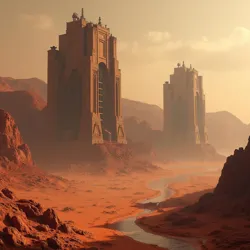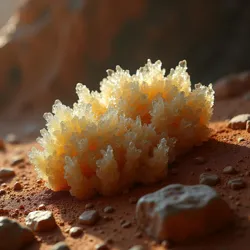The Nations of Mars
 Massive derelict terraforming engines stand as silent sentinels in the Valles Marineris, remnants of humanity's first steps on Mars
Massive derelict terraforming engines stand as silent sentinels in the Valles Marineris, remnants of humanity's first steps on MarsThe nations of Mars represent the culmination of human civilization's greatest diaspora, emerging from the ashes of Earth's Great Collapse over three millennia ago. Today, these distinct cultures inhabit a partially terraformed world, having evolved both culturally and biologically to survive in Mars' unique environment. While the original colonists successfully established breathable atmospheres and viable ecosystems, their descendants have largely lost the advanced technological capabilities that enabled interplanetary travel, instead developing rich new traditions and societies adapted to their harsh new home.
Major Nations and Territories
The Meridian Confederacy
Centered around the equatorial regions of Mars, the Meridian Confederacy represents one of the largest and most influential political entities on the planet. Founded by descendants of the original terraforming engineers, the Confederacy maintains a relatively high level of technological sophistication compared to other Martian nations. Their society places great emphasis on water conservation and atmospheric maintenance, with their elite Atmosphere Wardens serving as both technical experts and religious figures.
The Confederacy's capital of New Alexandria sits within a massive reinforced dome, housing millions of citizens in a carefully regulated environment. Their territory extends across much of the former Valles Marineris, where ancient terraforming machines still function under their stewardship.
The Frost Kingdoms
 The ice-carved metropolis of Glacierhearth, illuminated by aurora-powered light arrays
The ice-carved metropolis of Glacierhearth, illuminated by aurora-powered light arraysIn the northern polar regions, the Frost Kingdoms have developed a unique civilization adapted to the extreme cold and ice-rich environment. These hardy people have evolved slightly thicker skin and higher blood oxygen capacity than other Martian humans, allowing them to thrive in the sub-zero temperatures of their homeland. Their cities are carved directly into the ice caps, using ancient thermal technology to maintain habitable temperatures while harvesting water and oxygen from the frozen carbon dioxide deposits.
The Frost Kingdoms are governed by hereditary ice-lords known as the Rime Dynasties, who trace their lineage back to the original cryogenics specialists of the Mars colonization project. Their society emphasizes collective survival and resource sharing, though fierce competitions between different dynasties often erupt into territorial disputes.
The Blight and Earth Memory
Among all Martian nations, the memory of Earth persists as a mixture of historical fact and religious mythology. The Great Blight that supposedly rendered Earth uninhabitable remains a central element of Martian cultural consciousness, though the exact nature of this catastrophe has been lost to time. Many Martian scholars believe it involved a combination of environmental collapse and artificial pandemic, but historical records from that era are fragmentary at best.
The Promise of Return
Various religious and political movements across Mars maintain the goal of eventually returning to Earth, though the practical means to do so have been lost. The most prominent of these is the Terran Restoration Movement, which combines archaeological research into ancient spaceflight technology with a quasi-religious devotion to Earth as humanity's true home.
Archaeological Evidence
 Recently discovered pre-Collapse data crystals containing partial information about Earth's final days
Recently discovered pre-Collapse data crystals containing partial information about Earth's final daysRecent excavations of pre-Collapse sites have yielded tantalizing clues about humanity's exodus from Earth. The Olympus Archives, discovered beneath Olympus Mons, contain partially corrupted data about the final years of Earth-Mars communications, suggesting that the collapse of Earth civilization was more gradual than many Martian histories suggest.
Biological and Cultural Evolution
Martian Adaptations
Three thousand years of Martian habitation have led to notable biological changes in the human population. While still fully human, Martian people typically display:
- Increased lung capacity and more efficient oxygen absorption
- Denser bone structure to compensate for lower gravity
- Enhanced night vision due to Mars' dimmer sunlight
- Specialized adaptations unique to different regions and nations
Cultural Developments
The isolation from Earth has led to the development of distinctly Martian cultural practices and beliefs. The Calendar of Two Moons has replaced Earth-based time measurements, while new languages have evolved from the original colonists' tongues. The most widely spoken language, Ares Creole, combines elements of ancient Earth languages with new vocabulary describing uniquely Martian concepts and experiences.
Technology and Lost Knowledge
Current Technological Level
While Martian civilization has lost much of the advanced technology that enabled interplanetary travel, they maintain sophisticated capabilities in certain areas, particularly those essential for survival on Mars. The Guild of Atmospheric Sciences preserves crucial knowledge about maintaining Mars' artificial atmosphere, while the Aquifer Technocracy manages the planet's complex water distribution systems.
Recovery Efforts
Various institutions across Mars work to recover lost technological knowledge. The Universities of Olympus maintain vast archives of partial technical documents, while the Phobos Observatory continues astronomical observations using restored ancient equipment. However, the loss of key industrial capabilities, particularly in spacecraft construction and advanced electronics, has proven particularly difficult to overcome.
Current Political Landscape
Major Alliances
The political structure of Mars is dominated by several major power blocs, including:
- The Meridian-Frost Alliance, linking the equatorial and polar regions
- The Tharsis Consortium, controlling the major volcanic regions
- The Eastern Basin League, comprising the lowland nations
Ongoing Conflicts
Political tensions frequently arise over control of crucial resources, particularly water rights and atmospheric processing facilities. The War of the Wells in 2876 A.M. (After Migration) represented one of the largest conflicts over water resources, while the ongoing Dust Belt Disputes center on control of crucial atmospheric processing stations.
Contact with Earth
The Problem of Return
While many Martian nations maintain the theoretical goal of returning to Earth, several practical obstacles prevent this from being realized. The loss of spaceflight technology represents the most obvious barrier, but equally significant is the uncertainty about Earth's current condition. The Blight Quarantine Theory suggests that Earth remains contaminated by whatever catastrophe drove humanity to Mars, making return potentially suicidal.
Future Prospects
Recent technological recoveries, particularly in the field of long-range observation, have renewed interest in Earth's current state. The Hellas Impact Basin Observatory claims to have detected significant changes in Earth's atmospheric composition over the past century, suggesting ongoing environmental evolution. However, the true nature of these changes remains a matter of intense debate among Martian scholars and political leaders.
Trade and Economics
Resource-Based Economy
Mars' economy primarily revolves around the management and trade of essential resources: water, oxygen, and cultivated foodstuffs. The Guild of Resource Allocation maintains complex systems for tracking and trading these commodities between different regions and nations.
Technological Exchange
Despite the overall loss of advanced technology, certain regions maintain specialized knowledge that they trade with others. The Frost Kingdoms' expertise in ice processing is particularly valuable, while the Meridian Confederacy's atmospheric management capabilities make them crucial trading partners for all Martian nations.
Historical Documentation
The history of Mars since the Great Collapse is preserved through a combination of written records, oral traditions, and archaeological evidence. The Chronicians of Olympus maintain the most comprehensive historical archives, though their accuracy regarding events immediately following the collapse remains disputed. The discovery of the Deimos Data Cache in recent years has provided new insights into the early post-collapse period, though much of this information remains to be fully analyzed and understood.